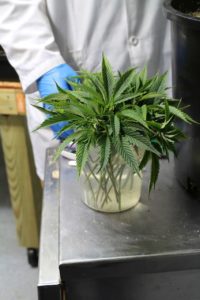 The documented medical use of cannabis dates back thousands of years, but modern science is just beginning to reveal the fascinating story of how cannabis evolved into the plant we know today. New research from the University of Toronto offers remarkable insights into how key cannabinoid components first developed and diverged into distinct varieties:
The documented medical use of cannabis dates back thousands of years, but modern science is just beginning to reveal the fascinating story of how cannabis evolved into the plant we know today. New research from the University of Toronto offers remarkable insights into how key cannabinoid components first developed and diverged into distinct varieties:
THC and CBD, bioactive substances produced by cannabis and sought by medical patients and recreational users, sprung to life thanks to ancient colonization of the plant’s genome by viruses, University of Toronto researchers have found.
…
The gene sequences for the THCA and CBDA synthases are nearly identical, supporting the idea that they come from the same gene that was duplicated millions of years ago. Over time, one or both gene copies became scrambled by invading retroelements, and by evolving separately, they eventually came to produce two different enzymes – CBDA synthase found in hemp (fibre-type), and THCA synthase in drug-type (marijuana). [utoronto.ca]
It will no doubt come as a surprise to many that the most sought-after components of the cannabis plant may have emerged from an ancient virus affecting its genome. Still, another way of explain this would be to recognize that these changes in the plant’s genetic code ultimately formed a powerful adaptation. The properties attained through the plant’s ability to produce THC and CBD led to a symbiotic relationship with humans that would lead to its gradual proliferation across the globe.
 Previous research has traced the transcontinental trade routes through which cannabis was exchanged between ancient societies. As its utility came to be understood, resulting commercial trade allowed the plant to travel great distances and adapt to new environments. These events, thousands of years in the past, played an important role in promoting the genetic diversity that makes possible the many unique flavors, aromas, and effects patients appreciate today. For example, indica strains, adapted to high-elevation environments, often exhibit differing characteristics than the equatorial sativa varieties. When modern cannabis breeders select for unique attributes in a new strain, they are building upon distinctive parental traits derived through several millennia of environmental adaptation to varied climates around the world.
Previous research has traced the transcontinental trade routes through which cannabis was exchanged between ancient societies. As its utility came to be understood, resulting commercial trade allowed the plant to travel great distances and adapt to new environments. These events, thousands of years in the past, played an important role in promoting the genetic diversity that makes possible the many unique flavors, aromas, and effects patients appreciate today. For example, indica strains, adapted to high-elevation environments, often exhibit differing characteristics than the equatorial sativa varieties. When modern cannabis breeders select for unique attributes in a new strain, they are building upon distinctive parental traits derived through several millennia of environmental adaptation to varied climates around the world.
Among the most significant implications to unlocking the cannabis genome, therefore, would be the potential ability to further hasten and perfect the process by which we isolate the plant’s most desirable traits:
The researchers expect the map will speed up breeding efforts to create new strains with desired medical properties as well as varieties that can be grown more sustainably, or with increased resistance to diseases and pests.
Such efforts will be aimed at enhancing the range of treatment options available to patients as a more complete picture of the cannabis plant’s therapeutic potential comes into view. The future of cannabis may bear little resemblance to its past, but the ancient roots of this important medicine remain relevant as we work to demonstrate its promise towards addressing the unmet medical needs of many patients today. Learn more from SWC Arizona in Tempe, AZ today.
Read More: New Study Traces Evidence of Cannabis Use in Ancient Cultures


 For both patients and their loved ones, Alzheimer’s Disease ranks among the most challenging conditions one can experience. This chronic neurodegenerative disorder leads to progressive symptoms including dementia, memory loss, emotional issues, and speech problems, among others. Few treatments exist and available therapies only address some symptoms, but not the progression of the disease itself. The search for new therapeutic options has led to significant interest in cannabis-based treatments and researchers are currently working to advance our understanding of the possible roles medical cannabis could play in the future of Alzheimer’s treatment.
For both patients and their loved ones, Alzheimer’s Disease ranks among the most challenging conditions one can experience. This chronic neurodegenerative disorder leads to progressive symptoms including dementia, memory loss, emotional issues, and speech problems, among others. Few treatments exist and available therapies only address some symptoms, but not the progression of the disease itself. The search for new therapeutic options has led to significant interest in cannabis-based treatments and researchers are currently working to advance our understanding of the possible roles medical cannabis could play in the future of Alzheimer’s treatment.

